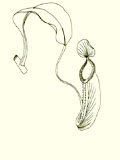

 |
 |
Flora (pdf)
Three new additions to the vascular plant flora of Hong Kong
by Ng Sai-chit
Livistona saribus (Lour.) Merr. ex A. Chev. Bull. Econ. Indo-chine 21: 501. 1919; Flora Reipublicae Popularis Sinicae 13(1): 27. 1991.
L. fengkaiensis X.W. Wei & M.Y. Miao J. S. China Agric. Univ. 3(1): 22-24. 1982; Flora of Guangdong 2: 446. 1991.
Palm tree 3-4 m tall. Similar to the widely planted Livistona chinensis (Jacq.) R. Br. but L. saribus differs in having significantly more robust spines on the petiole, especially towards the base, where the spines are up to 10-16 mm wide and 20-27 mm long (Fig. 1). Livistona saribus also has larger fruit than L. chinensis, about 3 cm long and 2 cm in diameter. No record or specimen of this species from Hong Kong has been seen. The species is recorded from S. Yunnan, W. Guangdong, Hainan, and Vietnam.
 |
| Fig. 1a. Base of petiole of L. saribus showing the robust spine |
The plant was seen near Yung Shu O, Sai Kung (SCNG 2127, 26 January 2000, HKU; SCNG 2529, 27 July 2000, HKU, AFCD (ripe fruit collected on 4 October 2002)). The tree was found growing in young secondary forest about 4-6 m tall at the bottom of a cliff on a steep rocky hillside along a stream at 160 m a.s.l. and is very unlikely to be a planted individual. The base of the tree has fallen and is lying horizontally, yet the plant has managed to grow in an upright position, although it is likely to fall in the very near future.
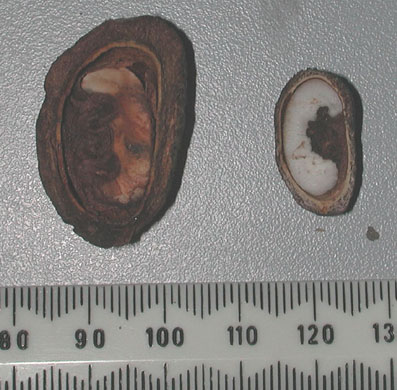 |
| Fig. 1b. Fruits of L. saribus |
Smilax ocreata A. DC. in A. DC. & C. DC. Monogr. Phan. 1: 191. 1878; Flora Reipublicae Popularis Sinicae 15: 234. 1978; Flora of China 24: 114. 2000.
Climber. Similar to the locally common Smilax lanceifolia Roxb. var. opaca A. DC. but differs in having broader round-ovate leaves and round perfoliate stipule which nearly completely encircle the stem. A widely distributed species in S. & SW. China, also recorded from India, Nepal, and Indo-China, but so far no specimen or record from Hong Kong has been seen.
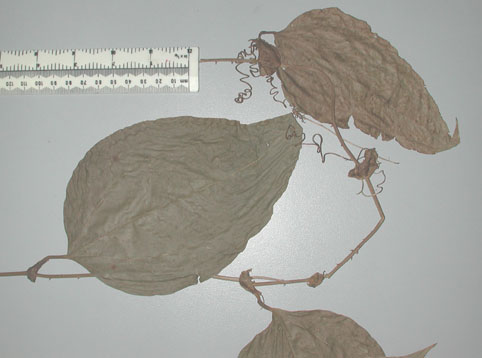 |
| Fig. 2. Smilax ocreata |
Only one plant was seen near abandoned farmland overgrown with Miscanthus sinensis next to a stream at Sheung Fa Shan, Tsuen Wan on 10 February 2002 (SCNG 3441, HKU, AFCD, KFBG).
Sticherus laevigatus (Willd.) C. Presl Tent. Pterid. 52. 1836.; Flora Reipublicae Popularis Sinicae 2:122.
Herb with horizontal creeping rhizomes and erect dichotomously branching fronds. Fronds 1.5-2 m tall and branch at least five times. Similar in growth form and pinnae shape to the two local Dicranopteris spp. (D. pedata Underw. and D. linearis Nakaike) but differs markedly in having leafy frond-axes, except for the primary and secondary branches of the fronds (Fig. 3 and 4). Pinnae on all the leafy frond-axes are identical in shape and texture to those on the terminal leafy branches. This species is very widely distributed in the tropics and had been recorded from Sri Lanka through Indo-China and Malaysia to Hainan and the Philippines. It is, however, very rare in mainland China and has only been recently reported from Guduoshan at Zhuhai, Guangdong (Yan et al., 2003). The present record is therefore the first record for Hong Kong and the second record for mainland China.
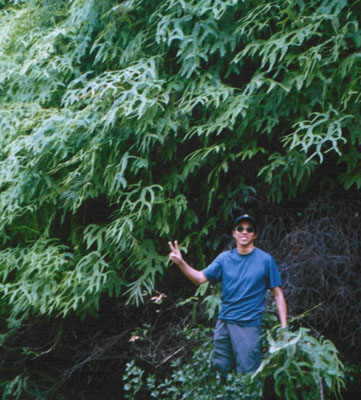 |
| Fig. 3a. The patch of Sticherus laevigatus found on a streamside hall shrubland. |
A single large colony, up to 3 m width x 10 m length, was seen in the forest margin about 1-3 m tall along a stream (110 m a.s.l.) above the Shatin entrance of the Tate’s Cairn Tunnuel, Shatin on 3 November, 2002 (SCNG 4122, HKU, AFCD, KFBG).
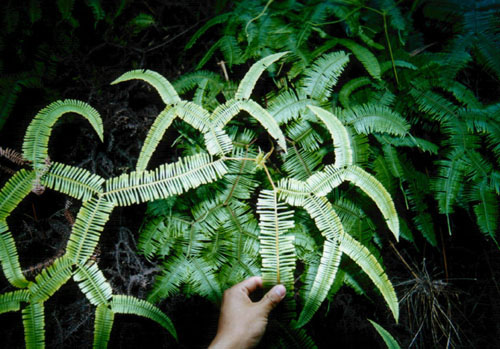 |
| Fig.3b. Sticherus laevigatus |
Acknowledgements
I am grateful to my hiking friends, Ronald K.Y. Ki, Lawman M.K. Law, Macro C.S. Poon, Zeeman C.M. Ng, Alfred C.K. Wong, for accompanying me in exploring the above unknown sites and making these discoveries. I would also like to thank Ken K.Y. So, Lam Wai Kei, and Ng Yiu Ming of the KFBG for collecting the ripe fruits of the Livistona.
Bibliography
Yan Y.H, Xing F.W. & Huang X.X. (2003). A survey on the ferns in Gudoushan Reserve, Guangdong, In: Living Forest.
|
|
P.12-13 |
|
Porcupine! |
 Copyright © 2000 |